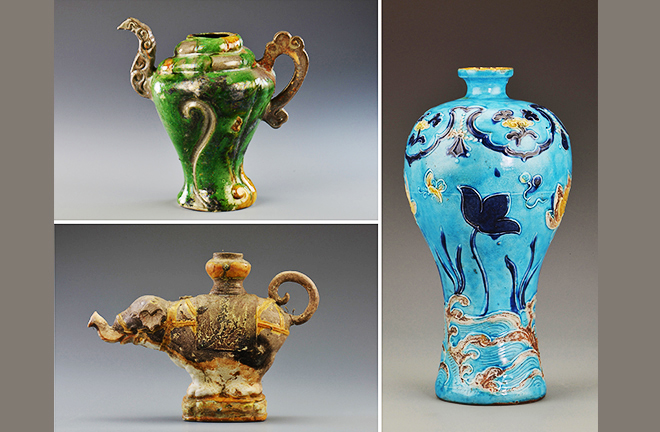Nation reveals top 10 archaeological discoveries of 2023

Porcelain artifacts unearthed from the Northwest Continental Slope No.1 Shipwreck Site in the South China Sea Photo: XINHUA
On March 22, a press conference was held in Beijing to unveil China’s top 10 new archaeological discoveries made in 2023.
The laureates, announced in chronological order, are: the Bashan Paleolithic site complex from 100,000 to 10,000 years ago in Yishui County, Shandong Province; the Keqiutou Neolithic site complex dating back 3,000 to 7,500 years in Pingtan County, Fujian Province; the Mopanshan Site in Langxi County, Anhui Province, from about the 6,000-year-old Majiabang Culture; the Qujialing Neolithic Site dating back 4,200 to 5,900 years in Jingmen City, Hubei Province; the Wangzhuang Site in Yongcheng City, Henan Province, of the Dawenkou Culture from about 5,000 years ago; the Shuyuanjie Cemetery in Zhengzhou, capital city of Henan, from the Shang Dynasty (c. 16th–11th century BCE); the Zhaigou Site dating back to the Shang Dynasty in Qingjian County, Shaanxi Province; the Sijiaoping Site in Lixian County, Gansu Province, from the Qin Dynasty (221–207 BCE); the Chencun Ceramic Kiln Site in Huozhou, Shanxi Province, from the Song (960–1279) to Qing (1644–1911) dynasties; and the Northwest Continental Slope No.1 and No.2 Shipwreck Site in the South China Sea from the Ming Dynasty (1368–1644).
The selected discoveries span a wide temporal range and encompass a broad geographical scope, highlighting the continuity, originality, unity, inclusivity, and peaceful nature of Chinese civilization from multifaceted perspectives.
Chen Xingcan, a Member of the Chinese Academy of Social Sciences (CASS), remarked that delving into the origins and evolution of civilization is a complex and protracted systematic endeavor. Such an undertaking demands the seamless integration of archaeological excavations and documentary analysis with technological means of the natural sciences.
Commenting on the commonalities of the newly listed archaeological finds, Chen noted that multidisciplinary collaboration featured prominently among them.
During the excavation of the Bashan site complex, much importance was attached to cooperative research across multiple disciplines. Spearheaded by a Paleolithic archaeology team, the project extended invitations to researchers from many research institutes to participate deeply in collecting samples for age determination and environmental analysis, reinforcing and extracting animal bones, conducting indoor CT scanning of fragile artifacts, and formulating preservation plans, as well as Paleo-topographical analysis and the analysis of ancient DNA samples. Together, their objective was to elucidate the interrelations among sites of the Bashan site complex and their cultural implications.
Phytolithic rice remains unearthed from the Keqiutou site complex date back to over 7,000 years ago. Traces of rice, foxtail millet, and broomcorn millet were also found in botanical imprints on pottery shards, marking the oldest-known rice on coastal islands in southeastern China. Further analysis of remnants revealed starch granules from crops such as rice, millet, and legumes, indicating diverse agricultural practices by the inhabitants of coastal islands throughout various historical eras.
At the Qujialing Site, significant progress was made in botanical archaeology, archaeological chronology, and remains analysis. According to remains analysis, pottery goblets and pot-shaped wares unearthed from the site were directly related to ancestral drinking customs. In terms of pottery craftsmanship, the discovery of the earliest-known high-temperature black glaze pottery has significantly extended the timeline of this technology in China by nearly 1,000 years.
In the excavation of the Shuyuanjie Cemetery, multidisciplinary research involved environmental archaeology, the identification and analysis of jade, gold, and bronze wares, and collagen and carbon-14 dating. Moreover, investigations into bone isotopes, musculoskeletal disorders, and ancient DNA were conducted. These endeavors yielded preliminary findings regarding the origins of mineral resources used in crafting bronzes and jade wares, the hygiene, diet, and health of ancient inhabitants of the cemetery site, and exchanges between ancient ethnic groups, providing important academic support for understanding the Shang culture in depth.
During the archaeological investigations into the Northwest Continental Slope No.1 and No.2 Shipwreck Site, researchers used the scientific research vessels Explorer-1 and Explorer-2, alongside the Shenhai Yongshi (Deep-sea Warrior) manned submersible. This represents the first systematic and scientific attempt made by Chinese underwater archaeologists to leverage archaeological theories, technologies, and approaches for investigating, recording, and studying an ancient shipwreck site in strict compliance with the requirements of underwater archaeology and with the assistance of deep-diving techniques and equipment. The project showcased the cross-disciplinary integration of deep-sea technology and underwater archaeology in China, indicating that Chinese deep-sea archaeology has attained a globally advanced status. This achievement marks a significant milestone in Chinese underwater archaeology.
“From the annual national top 10 archaeological findings in recent years, we can see that various technologies of the natural sciences have been applied to archaeology,” said CASS Member Wang Wei, adding that archaeology is now arguably the largest discipline that fuses the humanities and natural sciences.
By leveraging technological advancements, archaeologists can restore the realities of human life and society from different historical periods to the fullest extent possible, thereby better presenting archaeological findings to the public, Wang said.
Edited by CHEN MIRONG

 PRINT
PRINT CLOSE
CLOSE